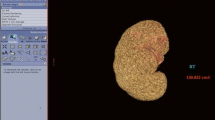Abstract
Background
Japanese GFR equation was developed from mainly chronic kidney disease (CKD) subjects. Only a small number of healthy subjects were included in the development and validation of the GFR equation. We assessed the performance of the equation in potential kidney donors.
Methods
A total of 113 potential kidney donors was included. The data of CKD subjects that were previously reported were also included for comparison. GFR (mGFR) was measured by inulin clearance. The estimated GFR (eGFR) was calculated by the Japanese GFR equation. Bias of the equation (eGFR − mGFR) and urinary creatinine excretion were evaluated.
Results
There was no significant difference between eGFR and mGFR in 340 CKD subjects (54.2 ± 31.6 and 55.7 ± 33.2 ml/min/1.73 m2, respectively). Contrarily, the eGFR was significantly lower than mGFR in 113 potential kidney donors (78.9 ± 16.2 and 93.6 ± 19.2 ml/min/1.73 m2, respectively). The biases in potential kidney donors with eGFR 30–59 and 60–89 ml/min/1.73 m2 were significantly greater than those in CKD subjects (−19.2 ± 12.2 and −18.3 ± 16.4 ml/min/1.73 m2 in potential kidney donors and −3.8 ± 15.6 and −3.4 ± 17.6 ml/min/1.73 m2 in CKD subjects, respectively). Creatinine excretion per body weight of potential kidney donors was significantly higher than that of CKD subjects, suggesting higher creatinine generation in potential kidney donors.
Conclusion
The Japanese GFR equation underestimated GFR in potential kidney donors. Higher creatinine generation compared with CKD subjects may contribute to the underestimation of GFR by the Japanese GFR equation in potential kidney donors.



Similar content being viewed by others
References
Eknoyan G, Lameire N, Barsoum R, Eckardt KU, Levin A, Levin N, et al. The burden of kidney disease: improving global outcome. Kidney Int. 2004;66:2681–3.
Levey AS, Coresh J, Greene T, Stevens LA, Zhang YL, Hendriksen S, et al. Using standardized serum creatinine values in the Modification of Diet in Renal Disease Study equation for estimating glomerular filtration rate. Ann Intern Med. 2006;145:247–54.
Stevens LA, Coresh J, Feldman HI, Greene T, Lash JP, Nelson RG, et al. Evaluation of the modification of diet in renal disease study equation in a large diverse population. J Am Soc Nephrol. 2007;18:2749–57.
Rule AD, Larson TS, Bergstralh EJ, Slezak JM, Jacobsen SJ, Cosio FG. Using serum creatinine to estimate glomerular filtration rate: accuracy in good health and in chronic kidney disease. Ann Intern Med. 2001;141:929–37.
Poggio ED, Wang X, Greene T, Van Lente F, Hall PM. Performance of the modification of diet in renal disease and Cockcroft–Gault equations in the estimation of GFR in health and in chronic kidney disease. J Am Soc Nephrol. 2005;16:459–66.
Matsuo S, Imai E, Horio M, Yasuda Y, Tomita K, Nitta K, et al. Revised equations for estimated GFR from serum creatinine in Japan. Am J Kidney Dis. 2009;53:982–92.
Kakuta Y, Okumi M, Ichimaru N, Abe T, Nonomura N, Okuyama A, et al. Utility of the Japanese GFR estimation equation for evaluating potential donor kidney function. Clin Exp Nephrol. 2010;14:63–7.
Tangri N, Stevens LA, Schmid CH, Zhang YL, Beck GJ, Greene T, et al. Changes in dietary protein intake has no effect on serum cystatin C levels independent of the glomerular filtration rate. Kidney Int. 2011;79:471–7.
Dharnidharka VR, Kwon C, Stevens G. Serum cystatin C is superior to serum creatinine as a marker of kidney function: a meta-analysis. Am J Kidney Dis. 2002;40:221–6.
Acknowledgments
The following investigators participated in the present study: Kazunari Tanabe (Tokyo Women’s Medical University), Hideki Ishida (Tokyo Women’s Medical University), Hattori Motoshi (Tokyo Women’s Medical University), Chikamoto Hiroko (Tokyo Women’s Medical University), Keiko Uchida (Tokyo Women’s Medical University), Atsushi Aikawa (Toho University), Ken Sakai (Toho University), Kazuhide Saito (Niigata University), Kunio Morozumi (Japanese Red Cross Nagoya Daini Hospital), Norihiko Goto (Japanese Red Cross Nagoya Daini Hospital), Schoichi Maruyama (Nagoya University), Yasuhiro Okabe (Kyushu University), Yoshifumi Miura (Kyushu University), Kei Kurihara (Kyushu University), Soushi Terasaka (Kyushu University), Sayako Kawanami (Kyushu University), Kohsuke Masutani (Kyushu University), Toshiaki Nakano (Kyushu University), Akihiro Tsuchimoto (Kyushu University) and Akiko Fujisaki (Kyushu University). This study was supported in part by a grant from the Japanese Society of Nephrology and a Health and Labor Sciences Research Grant from the Ministry of Health, Labor and Welfare on Renal Research, Japan.
Conflict of interest
All the authors have declared no competing interest.
Author information
Authors and Affiliations
Corresponding author
About this article
Cite this article
Horio, M., Yasuda, Y., Kaimori, J. et al. Performance of the Japanese GFR equation in potential kidney donors. Clin Exp Nephrol 16, 415–420 (2012). https://doi.org/10.1007/s10157-012-0586-6
Received:
Accepted:
Published:
Issue Date:
DOI: https://doi.org/10.1007/s10157-012-0586-6




